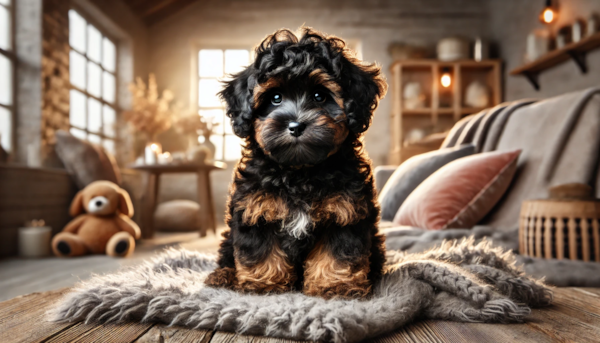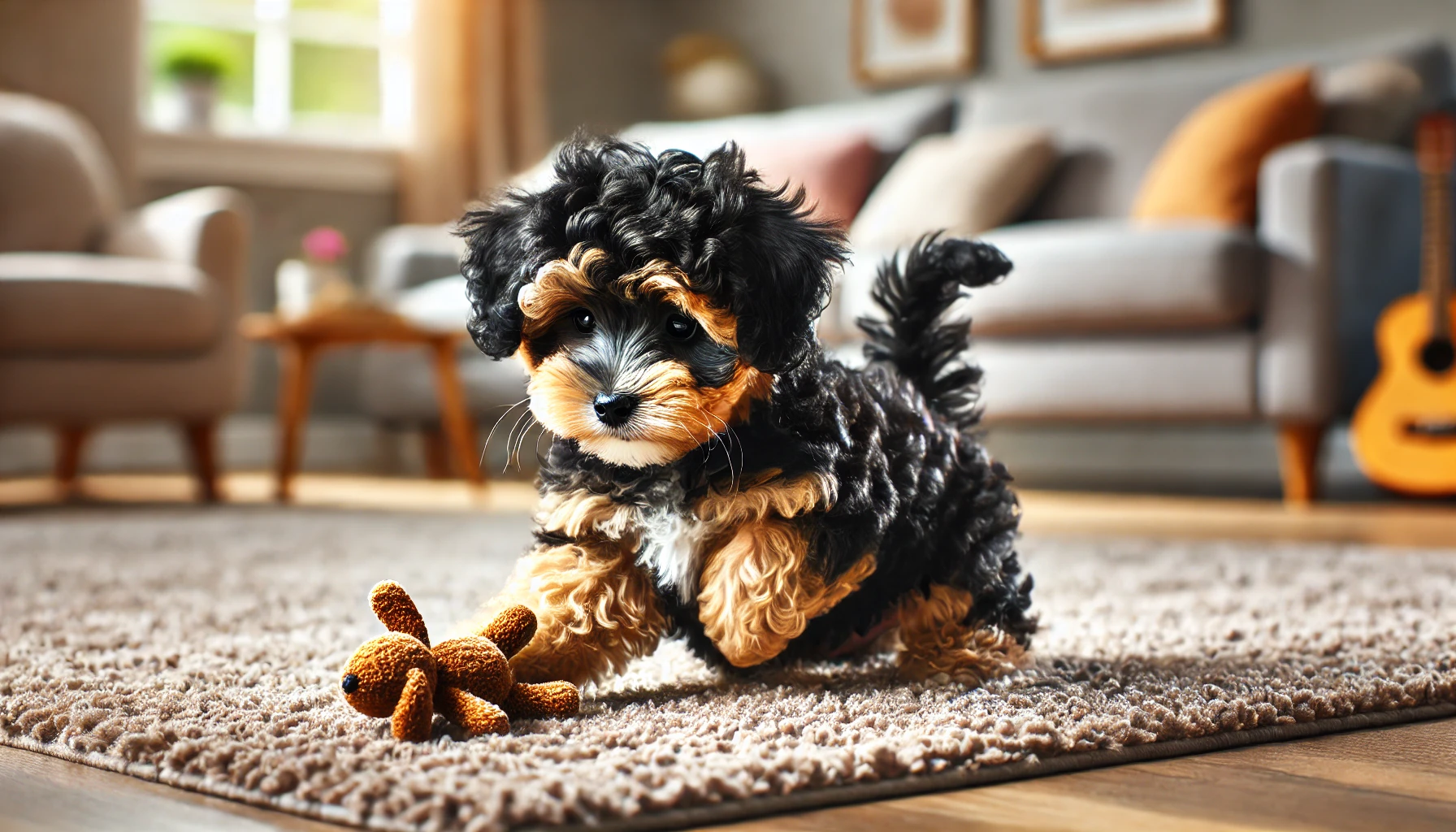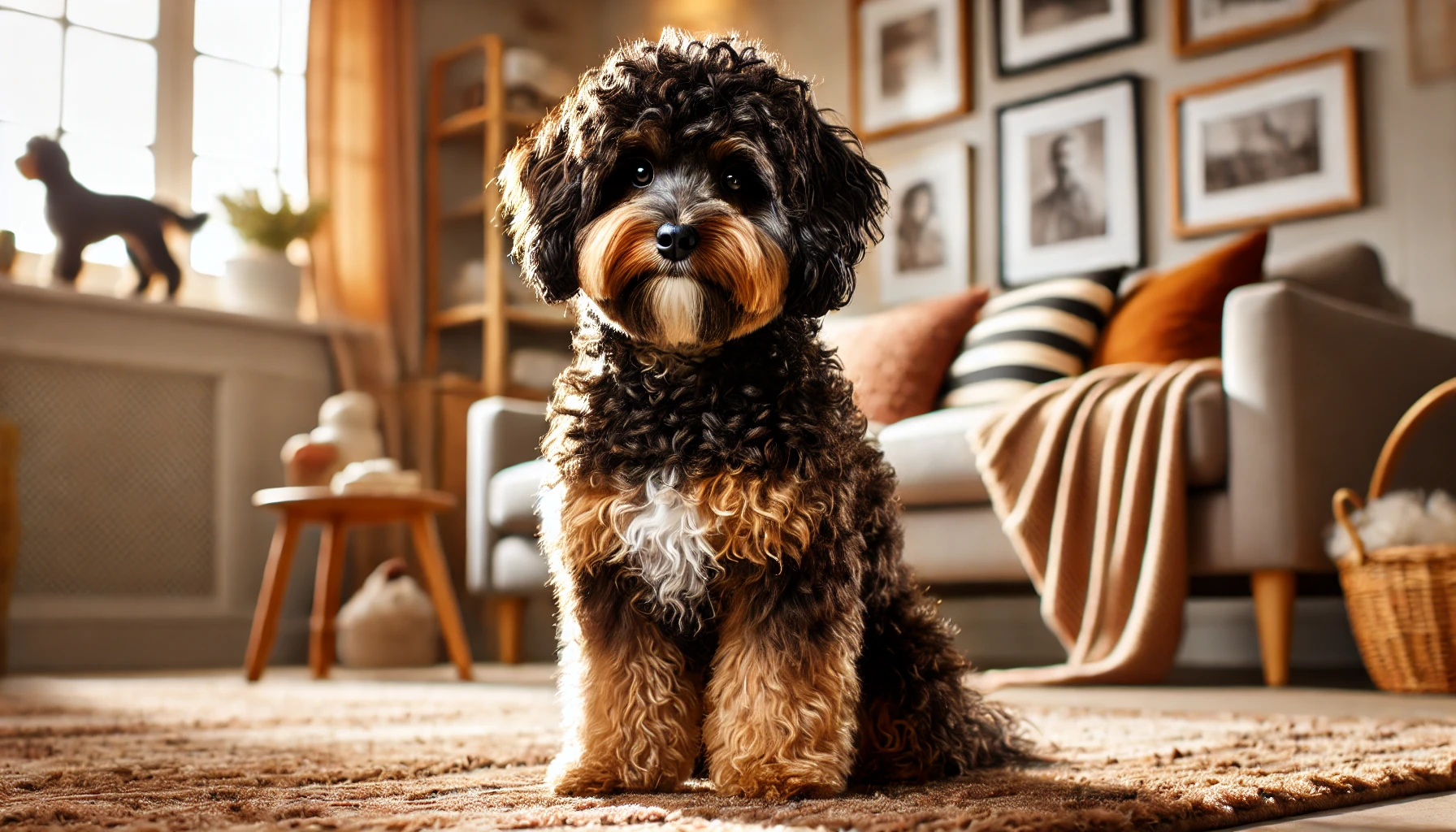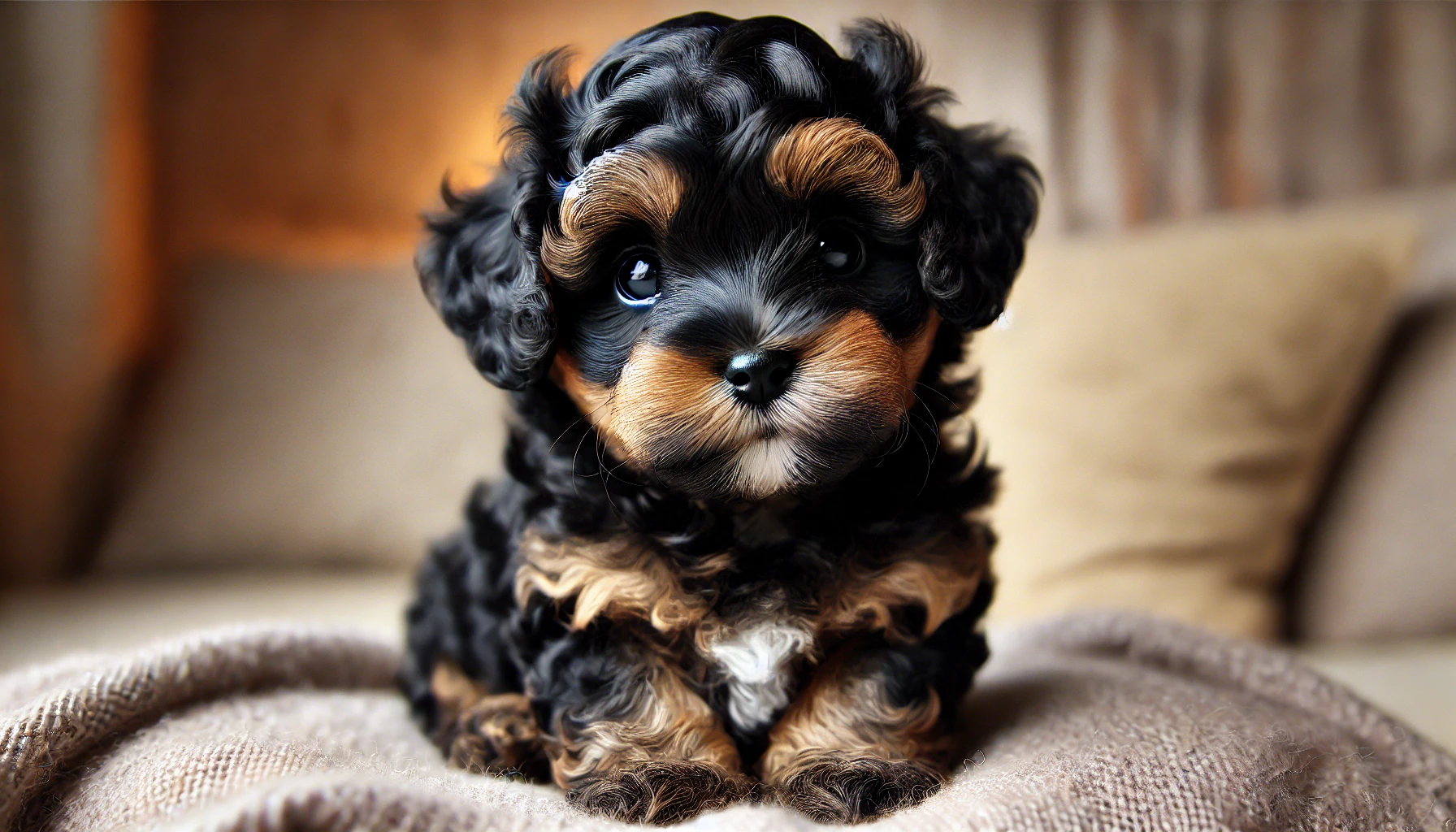
The black and brown Maltipoo is a rare and quite unique variation of the popular Maltipoo breed. These hybrid dogs, a mix between a Maltese and a toy or mini Poodle, are not only impossibly charming and affectionate but also have the intelligence and trainability inherited from their parent breeds. This guide provides everything you need to know about the black and brown maltipoo, including genetics, color rarity and prices, grooming, color fading, and more.
Table of Contents
What is a Black and Brown Maltipoo?
A black and brown Maltipoo is a rare doodle puppy that combines the playfulness of the Maltese with the intelligence of the Poodle. Known for its eye-catching coat, this Poodle mix often features a combination of black and brown fur, which can appear in several patterns:
- Solid Black and Brown: The coat has an even mix of black and brown all over, giving the dog a sleek look.
- Phantom Pattern: The dog has lighter tan patches on areas like the eyebrows, chest, and legs, adding a unique contrast to its darker coat.
- Parti Pattern: This variation features black and brown patches on a white base, resulting in a striking piebald look.
These designer dogs stand out from the more common cream or apricot Maltipoos, making them a popular choice for people who want a small dog breed that’s both unique and family friendly.
Why Are Black and Brown Maltipoos Rare?
Black and brown Maltipoos are considered rare due to the genetic traits required for these colors. The black and brown shades come from the Poodle parent, as Maltese dogs are only white. Both parents must carry specific recessive genes for the puppies to inherit these darker colors. In addition, black coats can fade to gray, and brown may lighten to a beige or café au lait shade as the dog matures.
RELATED: 20 Pros and Cons of Owning a Maltipoo
How Do You Get a Black and Brown Maltipoo?
If you’re wondering how to find a black and brown Maltipoo, the process isn’t as straightforward as choosing any Maltipoo puppy. Achieving this rare color combination involves specific breeding practices due to the genetic requirements. Here’s what you need to know:
The Breeding Process
Breeding for a black and brown coat requires careful selection of parent dogs that carry the necessary genes:
Genetic Pairing:
Since the Poodle parent can come in many colors, breeders often choose Poodles with a history of producing darker-colored offspring. They pair this Poodle with a Maltese or another Maltipoo that may also carry recessive genes for black or brown.
Generational Breeding:
- F1 Maltipoos: This is the first generation, where a purebred Poodle is crossed with a purebred Maltese. In F1 puppies, coat colors can vary widely because the genes are mixed for the first time.
- F1b Maltipoos: These are backcrosses, where an F1 Maltipoo is bred with a Poodle, making the puppies 75% Poodle and 25% Maltese. This generation often shows a higher likelihood of producing rare coat patterns, including black and brown.
- F2 Maltipoos: Bred from two F1 Maltipoos, F2 puppies have an even wider range of genetic combinations, which can increase the chances of a unique color pattern like black and brown appearing.
RELATED: Mixed Breed Generations Explained
Breeding isn’t always a guarantee for coat color, as genetic factors can be unpredictable. This makes black and brown Maltipoos more uncommon compared to more typical colors like white Maltipoos or even brown Maltipoos.
Where to Find a Black and Brown Maltipoo
If you’re searching for a black and brown Maltipoo, consider:
Reputable Breeders: Look for breeders who specialize in rare color combinations. They may perform genetic testing to increase the likelihood of producing black and brown coats. Be prepared for higher prices due to the rarity.
Rescue Organizations: Though it’s less common, you may find black and brown Maltipoos in rescue groups or reservation shelters. Keep an eye on breed-specific rescues that focus on Poodles, Maltese, or Doodle mixes.
RELATED: See available Maltipoo puppies for sale at Premier Pups
Temperament of Black and Brown Maltipoos

AI image of a black and brown Maltipoo puppy: generated with ChatGPT.
Black and brown Maltipoos, like other Maltipoos, are known for their friendly and playful nature. Their coat color may be unique, but their personality traits are similar across the breed. Here’s what you can expect from the temperament of a black and brown Maltipoo:
Affectionate and People-Oriented
Maltipoos are famous for their affectionate nature. They thrive on human interaction and love being around their families. These dogs often form strong bonds with their owners and can be quite “clingy,” earning them the nickname "Velcro dogs." If you’re looking for a dog that will happily follow you around the house and cuddle with you on the couch, a black and brown Maltipoo fits the bill perfectly.
Playful and Energetic
Don’t let their small size fool you—black and brown Maltipoos have plenty of energy to go around! They love to play games like fetch, tug-of-war, or just chase after their favorite toys. Regular playtime helps keep them happy and healthy. A couple of short walks each day, combined with some indoor play, will meet their exercise needs.
Intelligent and Easy to Train
Thanks to their Poodle heritage, black and brown Maltipoos are smart and quick learners. They respond well to positive reinforcement techniques such as treats, praise, and play. Start with basic commands like "sit," "stay," and "come," and gradually move on to more advanced tricks. Their eagerness to please makes them great candidates for agility training or fun dog sports.
Adaptable to Different Living Situations
One of the benefits of having a Maltipoo is their adaptability. Whether you live in an apartment or a house with a big backyard, they adjust well to different environments. Just keep in mind that they don’t like being left alone for long periods. If you have a busy lifestyle, consider having a dog sitter or arranging for pet daycare.
Common Behavioral Traits and How to Manage Them
Here are some behaviors you might notice in black and brown Maltipoos and tips for managing them:
- Separation Anxiety: Because they get attached to their owners, Maltipoos can experience separation anxiety. To help manage this, start leaving your dog alone for short periods and gradually increase the time. Make sure to provide plenty of toys or puzzle feeders to keep them entertained while you’re away.
- Barking: Maltipoos can be a bit vocal, especially if they’re excited or want your attention. Teaching commands like "quiet" or "enough" can help control excessive barking. Positive reinforcement works best when you catch them being quiet and reward that behavior.
- Sensitivity to Cold Weather: Due to their small size, they can get chilly easily. Make sure to keep them warm in colder weather with dog sweaters or blankets. This is especially important if you live in a colder climate.
RELATED: Are Maltipoos Smart?
Fun Fact: Why They’re Called "Velcro Dogs"
Black and brown Maltipoos (like all Maltipoos) have earned the nickname "Velcro dogs" because they love to stay close to their owners at all times. Don’t be surprised if your Maltipoo follows you from room to room—it’s just their way of showing love!
Training Tips for Black and Brown Maltipoo Puppies
Training a black and brown Maltipoo can be an enjoyable experience thanks to their intelligence and eagerness to learn. These small dogs respond best to positive reinforcement techniques, which makes training easier and more effective. Here’s how to get started with training your Maltipoo puppy:
Basic Commands
Begin with simple commands like "sit," "stay," "come," and "down." Use a cheerful voice and plenty of treats or praise to reward good behavior. Short, consistent training sessions (about 5-10 minutes each) are best for keeping your maltipoo puppy’s attention and making sure the lessons stick.
Positive Reinforcement
Black and brown Maltipoos respond very well to positive reinforcement, which means rewarding the behaviors you want to encourage. Here’s how you can make the most of this approach:
- Treats and Praise: Reward your puppy immediately after they follow a command. Use small treats and enthusiastic praise to show them they did something right.
- Play as a Reward: For a playful puppy, offering a favorite toy or a quick game of fetch can also be an effective reward.
Crate Training for Housebreaking
Crate training is a popular method for housebreaking because it helps establish a routine:
- Introduce the Crate Slowly: Make the crate a comfortable and positive space. Start by leaving the door open and letting your puppy explore it on their own.
- Establish a Potty Routine: Take your puppy outside frequently, especially after meals, naps, and playtime. Use consistent phrases like "go potty" to create a cue for bathroom breaks.
- Reward Success: Praise and reward your puppy every time they use the bathroom outside. Consistency is key to reinforcing this behavior.
Socialization
Black and brown Maltipoos can be a little shy if they aren’t exposed to different people, environments, and other dogs early on. To help your puppy grow into a confident adult:
- Introduce New Experiences Gradually: Start with low-stress situations, like meeting a calm dog or visiting a quiet park. Gradually increase exposure to busier places and different types of people.
- Puppy Classes: Consider enrolling your Maltipoo in puppy training classes. These provide a controlled environment where your puppy can meet other dogs and learn basic manners.
Addressing Common Training Challenges
Like any dog, Maltipoos may show some stubbornness or behavioral quirks during training. Here’s how to handle some common issues:
- Stubbornness: If your Maltipoo seems uninterested in following commands, try changing the type of reward you’re offering or make training more fun with a quick game in between lessons.
- Biting or Nipping: Teething puppies may try to nip during play. Redirect their attention to chew toys and teach them the "leave it" command to curb this behavior.
- Distractibility: Short attention spans can make training tough. Keep sessions brief and in environments with minimal distractions at first, gradually increasing the difficulty as your puppy progresses.
User Tip: Essential Training Tools for Your Maltipoo
Here are some tools that can make training your black and brown Maltipoo easier:
- Clicker: A clicker can help you mark good behavior instantly, making it easier for your puppy to understand what they did right.
- Treat Pouch: Keep treats handy during training sessions by using a treat pouch that clips onto your belt.
- Soft Leash and Harness: A comfortable harness and leash set is ideal for leash training and outdoor walks.
RELATED: How to train a puppy
Fun Fact: Why Do Maltipoos Love Learning Tricks?
Did you know that Maltipoos, thanks to their Poodle ancestry, often enjoy learning tricks and performing? Their intelligence and eagerness to please make them natural show-offs when it comes to tricks like "roll over" or "high five.
Grooming and Coat Care for Black and Brown Maltipoos

AI image of a black and brown Maltipoo adult: generated with ChatGPT.
Keeping your black and brown Maltipoo’s coat looking its best requires regular grooming. Their unique coat colors can be prone to fading or dullness without proper care. Here’s how to maintain a healthy, vibrant coat for your Maltipoo:
Regular Brushing
Brushing your Maltipoo’s coat is essential to prevent matting and keep the fur looking shiny:
- Frequency: Aim to brush your dog’s coat at least three to four times a week. Daily brushing is even better, especially if your Maltipoo has a longer or curlier coat.
- Tools: Use a slicker brush to detangle any knots and a fine-tooth comb to get rid of loose hair and prevent matting. For black and brown coats, a grooming spray can add shine and help prevent the hair from drying out.
Bathing Tips
Bathing keeps your Maltipoo’s coat clean and can help maintain the vibrancy of its colors:
- How Often to Bathe: Bathe your Maltipoo every 4-6 weeks. Bathing too often can strip natural oils from the coat, while too little may leave the fur dull and dirty.
- Use a Color-Enhancing Shampoo: Color-enhancing shampoos are designed to brighten dark fur and keep it from fading. These shampoos can help maintain the richness of the black and brown colors.
- Conditioner is a Must: Follow up with a moisturizing dog conditioner to keep the coat soft and prevent dryness. This is especially helpful for curly or wavy hair.
Haircuts and Trims
Regular haircuts are important to keep your Maltipoo looking neat and to avoid tangles:
- Popular Cuts: The “teddy bear” cut, which keeps the fur around the face rounded and fluffy, is a popular choice. You can also opt for a shorter “puppy cut” to reduce the need for frequent grooming.
- Frequency: Schedule a trim every 6-8 weeks, depending on the length of the coat. You can take your Maltipoo to a professional groomer or learn to do it yourself if you’re comfortable.
Tear Stains
Tear stains can sometimes be an issue for Maltipoos, especially around the lighter parts of their coat:
- Clean Around the Eyes Daily: Use tear stain wipes or a soft cloth dampened with warm water to gently clean around the eyes. This helps prevent staining and keeps the fur looking clean.
- Tear Stain Remover Products: Consider using a tear stain remover formulated for dogs to help lighten existing stains and prevent new ones from forming.
Seasonal Grooming Considerations
Adjust your grooming routine based on the season to keep your Maltipoo comfortable:
- Winter: During colder months, you may want to let the coat grow a bit longer for warmth. Use a moisturizing shampoo and conditioner to prevent dryness from indoor heating.
- Summer: In hotter weather, consider a shorter trim to keep your dog cool. Apply dog-safe sunscreen to areas with lighter fur if your Maltipoo spends a lot of time outdoors.
Grooming Checklist: Essential Tools for Your Black and Brown Maltipoo
Here’s a list of must-have grooming tools:
- Slicker Brush: For detangling knots and removing loose hair.
- Fine-Tooth Comb: Helps prevent matting and keeps the coat smooth.
- Color-Enhancing Shampoo: Maintains the richness of dark fur.
- Dog Conditioner: Keeps the coat soft and moisturized.
- Tear Stain Wipes: Prevents and cleans tear stains.
- Dog Clippers and Scissors: For trimming and maintaining coat length.
RELATED: Maltipoo Grooming Guide for Beginners
Fun Fact: Why Do Maltipoos’ Coats Change Color?
Did you know that black and brown Maltipoos may experience color changes as they age? This is due to the dilution gene, which can cause black fur to fade to gray or brown fur to lighten to a café au lait shade. Regular grooming and using color-enhancing products can help slow down this process.
Conclusion: Is a Black and Brown Maltipoo the Right Dog for You?

AI image of a black and brown Maltipoo puppy: generated with ChatGPT.
Black and brown Maltipoos are not just visually stunning; they are also known for their affectionate nature, intelligence, and adaptability. With their unique coat colors and charming personality, they can make a wonderful addition to many types of households. If you're considering adding a black and brown Maltipoo to your family, here are some final points to keep in mind:
Pros of Owning a Black and Brown Maltipoo
- Unique Appearance: Their rare coat color and patterns set them apart from more common Maltipoo colors.
- Loving and Loyal Companions: Maltipoos thrive on human interaction and are known for forming strong bonds with their owners. They’re ideal for families, singles, and seniors who want a friendly lap dog.
- Low-Shedding Coat: While they aren’t completely hypoallergenic, their low-shedding coat is a plus for allergy sufferers and those who prefer a cleaner home.
- Small and Adaptable: They adjust well to various living environments, from apartments to larger homes with backyards. Their small size also makes them easy to travel with.
Considerations Before Getting a Black and Brown Maltipoo
- Grooming Needs: Their coats require regular brushing, bathing, and occasional haircuts to stay healthy and look their best. If you're not prepared for the grooming commitment, you may need to factor in the cost of a professional groomer.
- Potential for Separation Anxiety: Because they get attached to their owners, Maltipoos may experience anxiety if left alone for extended periods. It’s important to ensure they get plenty of companionship and mental stimulation.
- Color Fading Over Time: Keep in mind that the rich black and brown colors may change as the dog matures, often lightening due to genetic factors. Using color-enhancing products and maintaining a good grooming routine can help slow the fading process.
Who Should Consider a Black and Brown Maltipoo?
- Families with Children: These dogs are gentle and playful, making them great companions for children, as long as interactions are supervised.
- First-Time Dog Owners: Their intelligence and eagerness to please make training straightforward, even for those who are new to owning a dog.
- People with Allergies: While not completely hypoallergenic, their low-shedding coat is easier on allergy sufferers compared to higher-shedding breeds.
- Seniors or Singles Looking for a Companion: Their loving nature and manageable size make them ideal lap dogs who are content to sit with you and keep you company.
Final Thoughts
A black and brown Maltipoo is more than just a beautiful dog breed. These dogs bring joy and affection into the lives of their owners. Whether you're drawn to their rare coat color or their loving personality, black and brown maltipoo dogs can offer a lifetime of companionship and fun. Remember to reserve or purchase from reputable breeders and give them the care and attention they deserve to keep them happy and healthy.
Scroll down to see FAQs about black and brown Maltipoos.
What To Read Next
Do Maltipoos Shed?
Maltipoo Grooming Guide for Beginners
Frequently Asked Questions
Are Black and Brown Maltipoos Rare? Yes, black and brown Maltipoos are considered rare because the genes responsible for these colors are recessive, meaning both parents need to carry them for the colors to show up in the puppies. Additionally, even when a black or brown coat is present at birth, the fur may fade or lighten over time due to genetic factors. This makes true black and brown Maltipoos even more uncommon.
How Much Do Black and Brown Maltipoos Typically Cost? The cost of a black and brown Maltipoo can range from $1,000 to $6,500, depending on factors like the breeder’s reputation, lineage, and whether the puppy is from a rare color line. Because black and brown coats are less common, some breeders may charge a premium for these color variations. It's always important to choose a reputable breeder who performs health checks to ensure you get a healthy puppy.
Do Black and Brown Maltipoos Need Special Grooming? While black and brown Maltipoos don’t need more grooming than other Maltipoos, there are some considerations to keep their coats looking vibrant. Using shampoos designed for darker coats can help maintain the richness of their color. Additionally, brushing three to four times a week helps distribute natural oils throughout the coat and keep it shiny.
Do Black and Brown Maltipoos Shed? Maltipoos are considered low-shedding dogs, which is one of the reasons they are popular among allergy sufferers. However, they are not completely hypoallergenic, no dog breed is. Regular grooming helps to minimize shedding and reduce allergens. Their low-shedding coats, inherited from the Poodle side, also mean that any loose hair is more likely to get caught in the curls rather than fall off.
Can Black and Brown Maltipoos Change Color? Yes, it's common for black and brown Maltipoos to experience changes in coat color as they mature.
Are Black and Brown Maltipoos Suitable for Families with Children? Yes, black and brown Maltipoos, like all Maltipoos, are known for their friendly and gentle temperament. They are great with children due to their affectionate nature and playful behavior. However, because they are small, it's essential to supervise playtime with very young children to ensure the dog isn't handled too roughly.




